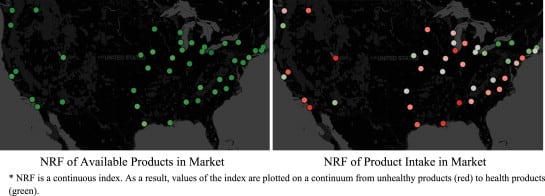The study, published in Economic Letters, investigated the evolution of nutritional quality in the US using RTE cereals as a case study. The researchers looked at individual nutrients like sodium, fat and sugar and also used the Nutrition-Rich Foods Index (NRF) to consider the overall health of the cereal product.
The Nutrient-Rich Foods Index
The NRF is a formal nutrient scoring system that looks at nutrients to encourage like protein, fiber, vitamins A, C and E, calcium, iron, magnesium and potassium; as well as nutrients to limit such as fat, added sugar and sodium.
Findings showed “consumption gravitates towards less healthy options available in the market”.
The researchers tracked nutritional quality of RTE cereals and actual consumption between 1988 and 2011 using historical data and found consumption (using a weighted average) consistently registered below nutritional quality.
“This implies that, while healthier alternatives may be available, on average US consumers have disproportionally favored unhealthier cereals,” they wrote.
Can’t find that cereal?
The researchers acknowledged the argument that consumption could relate to availability – namely that healthier RTE cereals were sold in wealthier neighborhoods.
However, data plotting the ratio of product availability in major metropolitan areas (number of stores offering a product and total number of stores in that area) showed otherwise.
Findings showed that in 2001 across the US, healthier products were available in “slightly more stores” than unhealthy food.
“If the hypothesis of discriminatory access to healthy foods were correct, we would expect to see a correlation that is negative and larger in absolute value; indicating that healthy foods are available at significantly fewer stores than unhealthy varieties. Thus, the data fails to support the stated hypothesis,” the researchers wrote.
In addition, the researchers plotted a map of the US indicating where nutrient rich RTE cereals were sold in 2011 and where they were most consumed.

Findings showed “great heterogeneity” (diversity) across geographical regions in the nutritional quality of cereals consumed.
“Regional variation in dietary profiles has remained consistently large even as product offerings became uniform,” they wrote.
Priced out of the market?
The researchers acknowledged the argument that consumers could be priced out of the healthier cereal market but said data had suggested this was not the case.
Findings showed no strong association between price and nutrition quality during the period 1988 and 2011.
Even when broken down to look at “three important nutrients” – sugar, sodium and fiber – the researchers said: “To the contrary, the evidence is consistent with the notion that, equal prices notwithstanding, consumers still gravitate towards less nutritious options.”
Shaping the future beyond industry regulation

The researchers said such findings proved invaluable for policy-makers seeking to combat obesity and rising medical costs associated with it.
With this research in mind, they said policy makers could better focus on where to direct resources – either towards producer-focused policies such as banning unhealthy ingredients or consumer-directed interventions like nutrition-focused health education in elementary schools.
“The data indicates that neither prices nor local availability are responsible for unhealthy eating. While our findings are specific to a single product category, they speak to broader policy strategies regarding healthful eating and suggest that efforts to improve dietary intake may be more effective if focused on consumer preferences rather than supply-side regulation,” they said.
Source: Economic Letters
Published online ahead of print, doi: 10.1016/j.econlet.2015.05.021. Published: August 2015, Volume 133, Pages 105-108
“Evolution of nutritional quality in the US: Evidence from the ready-to-eat cereal industry”
Authors: E. Wang, C. Rojas and C. Bauner
